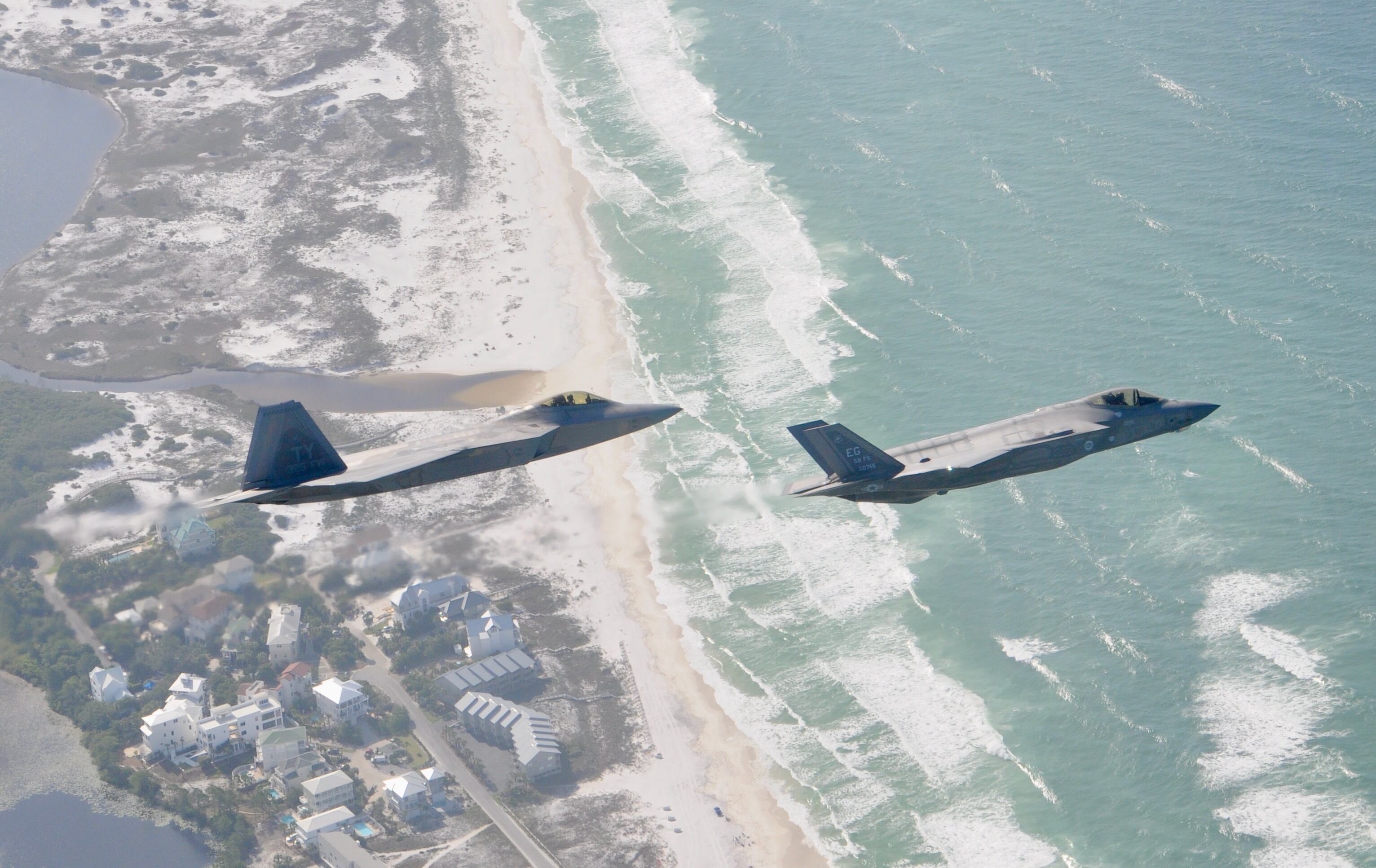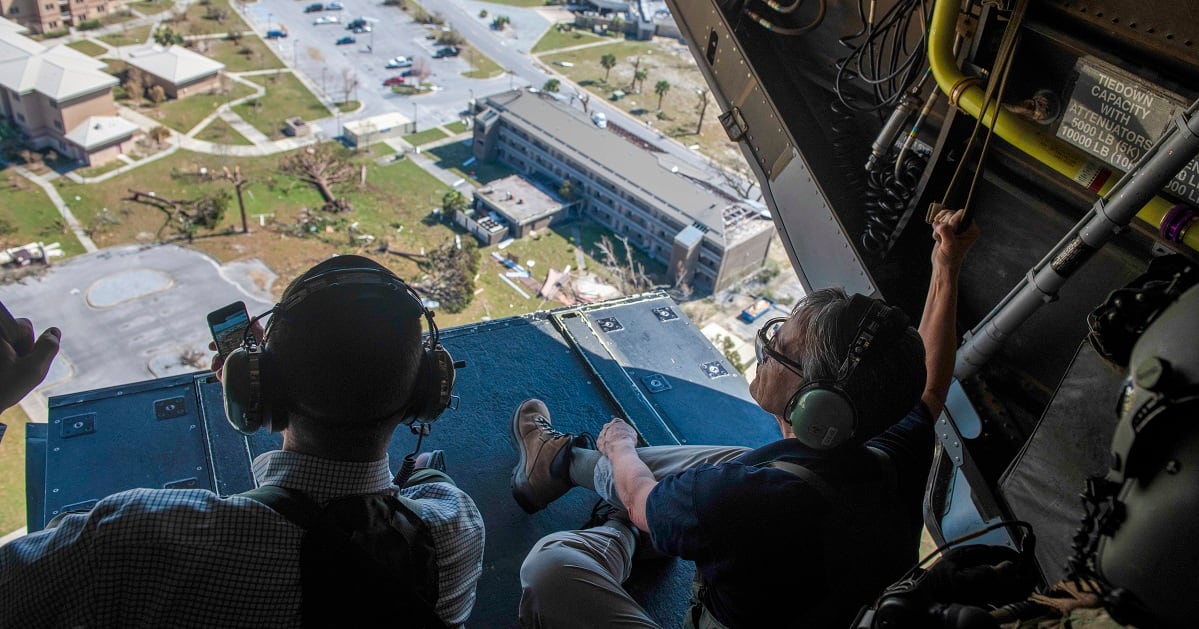Some small technology could make a big difference as Tyndall Air Force Base looks to rebuild as a 21st-century “smart” installation.
The fighter jet base in the Florida Panhandle is taking three-dimensional scans of its buildings and what grounds that were left after Hurricane Michael, a Category 5 storm, pummeled the installation in late 2018. That data will generate computer renderings of base infrastructure that could change how airmen — from maintenance crews to security forces — handle their jobs.
Using sophisticated cameras and a “cool backpack” with GPS-enabled radars that take laser measurements, a team captured the interior and exterior layouts of Tyndall’s facilities, roads and runways, Lowell Usrey, integration division chief in the office overseeing Tyndall’s reconstruction, told Air Force Times. Those scans of the nooks and crannies on base will pair with existing blueprints and geographic data to create the 3D image known as a “digital twin.”
USAF is partnering with Booz Allen Hamilton and Virginia-based Ares Security under a $10 million, three-year prototyping agreement to get the concept up and running.
Think of it in the same way as a Roomba maps a home’s layout to know where to vacuum, or how a Google Maps car uses a 3D depth sensor to create a model of the world around it, officials with the Tyndall reconstruction program office said.
“It will tell you where potholes are, it can tell you where cracks are in that pavement. That potentially enables future use cases where you could do artificial intelligence analytics of that pavement to see where it’s going to fail,” Usrey said of one scanning system.
Most importantly, the team is building digital models of the flight line area that will host three F-35A Lightning II fighter jets starting in 2023, and potentially other airframes like the MQ-9 Reaper drone. Mapping the mission support group facilities is also a high priority so the Air Force can see how the key mechanical infrastructure might be affected by another big storm.
RELATED

“Digital twin” technology is starting to take hold across the Air Force, which wants to use it for purposes like testing aircraft upgrades without a physical prototype.
“The digital twin for an installation is so much more interesting, I think, than maybe just the digital twin of an aircraft or something of that nature,” Usrey said. “It enables so many things.”
For instance, he said, what if another hurricane hit Tyndall? What facilities might be underwater if a storm surge approached the base? A digital twin offers a way to game out those scenarios to be better prepared for the real event.
There’s a multitude of potential uses outside of disaster planning as well. A digital blueprint could feed into virtual-reality goggles that show maintenance crews where problems arise inside a wall. It could offer insight into how efficiently Tyndall is using energy and water, or model the number of fighter jets that could park along the flight line.
The Tyndall Program Management Office envisions all that data could flow into a centralized “Installation Resilience Operations Center,” where base leaders could keep an eye on everyday building metrics or better respond to an emergency like an active shooter.
That center could be particularly plugged into security personnel, who would need precise information about the base’s layout to handle a breach.
It could mean a major overhaul of security forces planning, from basic tabletop modeling to a video game-like approach backed by real data. That’s handy for scenarios such as: Could a gate runner reach jets in a hangar, or another off-limits area?
“They would probably put a piece of paper and be like, OK, this is a car, and then, like, some popsicle sticks, and that would be the gate,” Usrey said. “They would probably be building this out in a 3D format, guesstimating distances and sizes and times that it would take.”
Being able to work through thousands of safety scenarios can lead to better investments in security systems as well — a more pressing issue as the Air Force reviews its force-wide base security practices for the second time since 2017.
A digital twin is also going to help keep Tyndall’s various fighter and weapons testing missions up and running in the midst of a now nearly $5 billion reconstruction project over the next several years, said Lance Marrano, an Army engineer serving as the rebuild effort’s science and technology adviser.
RELATED

They can use the scanned model to look at how the base might operate in the near and distant future, and to better understand the base’s transition back into a fully functioning installation, Marrano added. Workers can rescan areas to update the digital twin as infrastructure changes.
“As we go through the construction process, just being able to gauge our progress and visualize that progress, and [being] able to resolve any conflicts of time and space … is going to help us deliver this mission,” he said.
The program office anticipates it will be 18 months to two years before airmen at Tyndall are using the digital twins on a regular basis. They hope to set a good example for other bases that are interested — like nearby Eglin Air Force Base, Fla. — so the technology can eventually scale up across the service.
“We believe it has strong potential. We want to make sure that it has that good return on investment, so to speak, to help the Air Force serve our nation,” Marrano said.
Rachel Cohen is the editor of Air Force Times. She joined the publication as its senior reporter in March 2021. Her work has appeared in the Washington Post, the Frederick News-Post (Md.), Air and Space Forces Magazine, Inside Defense, Inside Health Policy and elsewhere.





